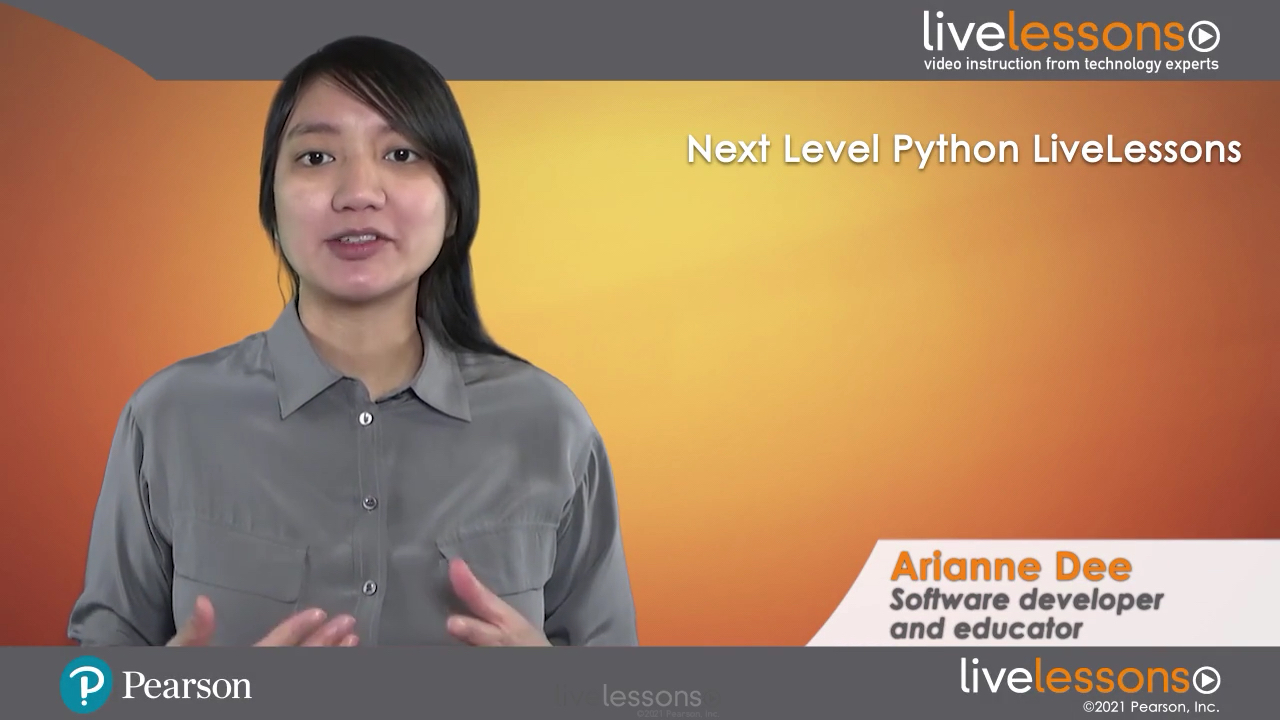Next Level Python LiveLessons (Video Training)
- By Arianne Dee
- Published Apr 30, 2021 by Addison-Wesley Professional.
Online Video
- Your Price: $239.99
- List Price: $299.99
- About this video
Video accessible from your Account page after purchase.
Register your product to gain access to bonus material or receive a coupon.
Description
- Copyright 2021
- Edition: 1st
- Online Video
- ISBN-10: 0-13-690402-5
- ISBN-13: 978-0-13-690402-1
7+ Hours of Video Instruction
While Python is a great beginner language, you will need to know more than conditionals, functions, and loops to be a competent Python developer. This video lesson is meant as a follow-up to Arianne's Introduction to Python LiveLessons course. In it, you will learn essential skills to become a proper Python developer, like using external libraries, managing project environments, handling exceptions, and making HTTP requests. By the end of this lesson, you will have created a web scraper in Python that gathers data from a website and outputs it into a CSV formatted file. You will also be introduced to key software construction concepts like testing, debugging, and refactoring.
Description
Python was originally designed with learners in mind. It is also used by professional developers in a wide range of applications, such as web programming, data science, artificial intelligence, and DevOps. Python is the fastest growing, most widely used language, and aspiring developers want to learn.
While Python is a great beginner language, you need to know more than conditionals, functions, and loops to be a competent Python developer. This video lesson is meant as a follow up to Arianne's Introduction to Python LiveLessons course.
In this LiveLessons, you learn essential skills to become a proper Python developer, such as using external libraries, managing project environments, handling exceptions, and making HTTP requests. By the end of the lessons, you will have created a web scraper in Python that gathers data from a website and outputs it into a CSV formatted file. Along the way, you will also be introduced to key software construction concepts like testing, debugging, and refactoring.
Skill Level
- Beginning to Intermediate
What You Will Learn
- While Python is a great beginner language, you will need to know more than conditionals, functions, and loops to be a competent Python developer.
- You will learn essential skills to become a proper Python developer, like using external libraries, managing project environments, handling exceptions, and making HTTP requests.
- You will have created a web scraper in Python that gathers data from a website and outputs it into a CSV formatted file.
- You will be introduced to key software construction concepts like testing, debugging, and refactoring.
Who Should Take This Course
- Software developers, programmers, web developers
Course Requirements
Prerequisites:
- Some experience coding in Python 3
- Basic understanding of the following concepts in Python: types, functions, conditionals, lists, while loops, and for loops
About Pearson Video Training
Pearson publishes expert-led video tutorials covering a wide selection of technology topics designed to teach you the skills you need to succeed. These professional and personal technology videos feature world-leading author instructors published by your trusted technology brands: Addison-Wesley, Cisco Press, Pearson IT Certification, Sams, and Que. Topics include IT Certification, Network Security, Cisco Technology, Programming, Web Development, Mobile Development, and more. Learn more about Pearson Video training at http://www.informit.com/video.
Video Lessons are available for download for offline viewing within the streaming format. Look for the green arrow in each lesson.
Sample Content
Table of Contents
Introduction
Lesson 1: Look at Python Basics
1.1 Setup your environment
1.2 Review functions, conditionals, and lists
1.3 Store data in dictionaries
1.4 Handle exceptions
1.5 Work with dates
1.6 Use regular expressions
Lesson 2: Work with Files
2.1 Read data from a file
2.2 Write data to a file
2.3 Read and write to CSV files
Lesson 3: Manage Your Python Environments
3.1 Work with the command line
3.2 Install external libraries using pip
3.3 Create virtual environments using venv
3.4 Understand git and GitHub
3.5 Set up your code to be shared
3.6 Clone a project
Lesson 4: Choose an IDE
4.1 Explore Jupyter notebooks and Spyder for data science
4.2 Compare PyCharm and VS Code for software development
4.3 Configuring PyCharm
4.4 Learning PyCharm shortcuts
Lesson 5: Understand Python Modules and Namespaces
5.1 Look at modules and imports
5.2 Understand the use of __init__.py files
5.3 Learn about namespaces and scope in Python
Lesson 6: Debug and Test Your Code
6.1 Debug with PyCharm’s debugger tool
6.2 Testing with unittest and pytest
6.3 Practice testing and debugging
6.4 Refactor your code
Lesson 7: Getting Data from the Web
7.1 Use the Requests library to make HTTP requests
7.2 Review web pages and HTML
7.3 Parse HTML documents with Beautiful Soup
7.4 Scrape authenticated sites
7.5 Make API requests
Lesson 8: Create a Web Scraping Application
8.1 Discuss the project and web scraping ethics
8.2 Set up the environment
8.3 Scrape data from Wikipedia
8.4 Save table data as CSV
8.5 Get detailed data from Wikipedia
8.6 Refactor code in PyCharm
Lesson 9: Put Your Project on the Internet
9.1 Run your code in the Cloud
9.2 Create an Anvil web app
Summary
More Information

